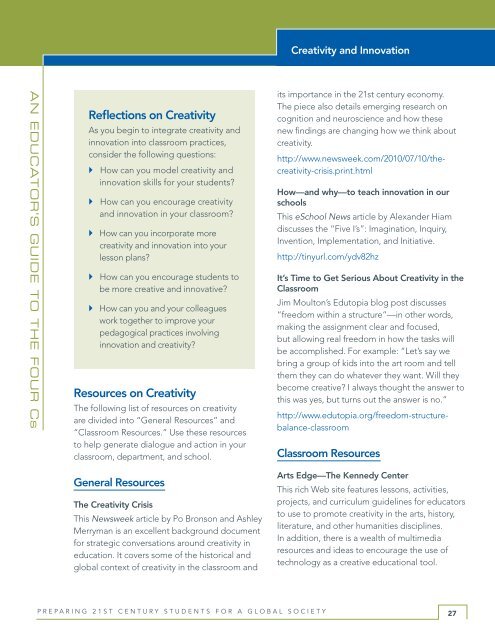Preparing 21st Century Students for a Global Society
Preparing 21st Century Students for a Global Society
Preparing 21st Century Students for a Global Society
You also want an ePaper? Increase the reach of your titles
YUMPU automatically turns print PDFs into web optimized ePapers that Google loves.
An EducAtor’s GuidE to thE Four cs<br />
Reflections on Creativity<br />
As you begin to integrate creativity and<br />
innovation into classroom practices,<br />
consider the following questions:<br />
` `How<br />
can you model creativity and<br />
innovation skills <strong>for</strong> your students?<br />
` `How<br />
can you encourage creativity<br />
and innovation in your classroom?<br />
` `How<br />
can you incorporate more<br />
creativity and innovation into your<br />
lesson plans?<br />
` `How<br />
can you encourage students to<br />
be more creative and innovative?<br />
`<br />
` How can you and your colleagues<br />
work together to improve your<br />
pedagogical practices involving<br />
innovation and creativity?<br />
Resources on Creativity<br />
The following list of resources on creativity<br />
are divided into “General Resources” and<br />
“Classroom Resources.” Use these resources<br />
to help generate dialogue and action in your<br />
classroom, department, and school.<br />
General Resources<br />
The Creativity Crisis<br />
This Newsweek article by Po Bronson and Ashley<br />
Merryman is an excellent background document<br />
<strong>for</strong> strategic conversations around creativity in<br />
education. It covers some of the historical and<br />
global context of creativity in the classroom and<br />
P r e P a r i n g 2 1 s t C e n t u r y s t u d e n t s f o r a g l o b a l s o C i e t y<br />
Creativity and Innovation<br />
its importance in the <strong>21st</strong> century economy.<br />
The piece also details emerging research on<br />
cognition and neuroscience and how these<br />
new findings are changing how we think about<br />
creativity.<br />
http://www.newsweek.com/2010/07/10/thecreativity-crisis.print.html<br />
How—and why—to teach innovation in our<br />
schools<br />
This eSchool News article by Alexander Hiam<br />
discusses the “Five I’s”: Imagination, Inquiry,<br />
Invention, Implementation, and Initiative.<br />
http://tinyurl.com/ydv82hz<br />
It’s Time to Get Serious About Creativity in the<br />
Classroom<br />
Jim Moulton’s Edutopia blog post discusses<br />
“freedom within a structure”—in other words,<br />
making the assignment clear and focused,<br />
but allowing real freedom in how the tasks will<br />
be accomplished. For example: “Let’s say we<br />
bring a group of kids into the art room and tell<br />
them they can do whatever they want. Will they<br />
become creative? I always thought the answer to<br />
this was yes, but turns out the answer is no.”<br />
http://www.edutopia.org/freedom-structurebalance-classroom<br />
Classroom Resources<br />
Arts Edge—The Kennedy Center<br />
This rich Web site features lessons, activities,<br />
projects, and curriculum guidelines <strong>for</strong> educators<br />
to use to promote creativity in the arts, history,<br />
literature, and other humanities disciplines.<br />
In addition, there is a wealth of multimedia<br />
resources and ideas to encourage the use of<br />
technology as a creative educational tool.<br />
27


